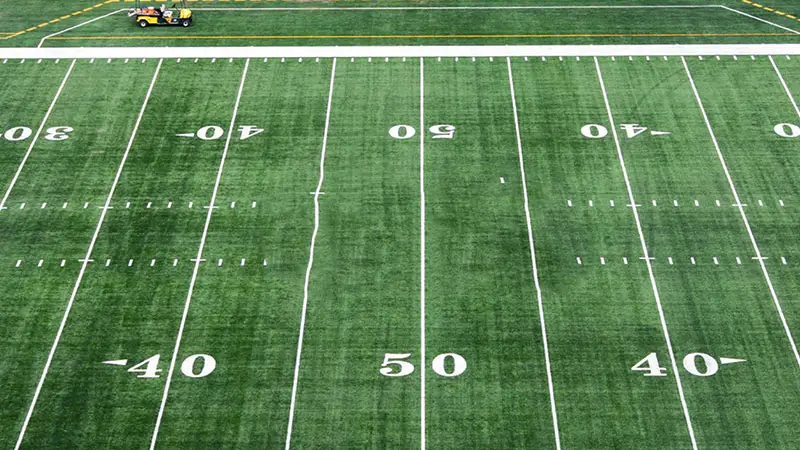The 50-yard line in football isn’t just a mark on the field; it’s the heartbeat of the game. Positioned at the exact midpoint, it serves as the ultimate vantage point for fans and players alike.
From this central spot, every play unfolds with perfect symmetry, offering a unique perspective on the strategy and skill that define each match.
For spectators, securing a seat along the 50-yard line means experiencing the game in its most balanced and thrilling form. It’s where the action feels closest and the energy of the crowd peaks.
For players, crossing this line often signifies a critical shift in momentum, making it a psychological battleground as much as a physical one.
Understanding the significance of the 50-yard line can deepen one’s appreciation for the sport, highlighting why it’s considered prime real estate in football culture.
Understanding the 50 Yard Line
The 50-yard line in football serves as a pivotal marker on the field. It represents not just the midpoint of the playing area but also a critical element in game strategy and fan experience.
Importance in Football
The 50-yard line plays a crucial role in game dynamics. During kickoffs, teams aim to gain the best field position, often targeting the 50-yard line for strategic advantage.
It’s also the reference point for the broadcasting team, providing balance and perspective during live coverage. Players crossing this line can mark a momentum shift, indicating a team’s movement into opponent territory.
Location and Significance
Located at the center of the football field, the 50-yard line splits the field into two equal halves. This central positioning ensures that it’s a focal point during gameplay.
Fans seated at stadiums often prefer seats along the 50-yard line for the best vantage point, enjoying a panoramic view of the entire field.
This line also serves as a tactical marker for coaches and players, guiding offensive and defensive strategies throughout the game.
Dimensions and Markings
The football field’s dimensions and markings play critical roles in the game’s execution and strategy. Understanding these elements can enhance one’s appreciation of the sport.
Length of the Football Field
The length of a standard football field measures 100 yards. This measurement excludes the end zones, which add 10 yards each to the total length.
Including the end zones, the full length of the field reaches 120 yards. The 50-yard line, positioned at the midpoint, divides the field into two equal halves.
Yard Lines and Hash Marks
Yard lines run parallel to the width of the field, spaced 5 yards apart, and stretch from one sideline to the other. These lines assist referees and players in determining the ball’s location on the field.
In tandem with yard lines, hash marks provide additional positional guidance. Located along the length of the field, they vary in width between professional and collegiate fields.
NFL fields feature hash marks spaced 18 feet 6 inches apart, while college fields have hash marks 40 feet apart.
End Zones and Field Goals
End zones, extending 10 yards each, are situated at both ends of the field. Painted with team logos, they serve as scoring destinations during touchdowns.
Field goal posts, located at the back of each end zone, stand 10 feet high with a crossbar spanning 18 feet 6 inches in the NFL and 23 feet 4 inches in college football. These posts are targets for field goals and extra points.
The Role of the 50 Yard Line
The 50-yard line holds a significant position in football. It serves as more than a field marker.
In Gameplay
Teams often change strategies around the 50-yard line. This line represents the midpoint, turning field positions more favorable for offensive and defensive plays.
Advancing past this line increases scoring opportunities since the opposing team’s territory begins. For example, a ball carrier crossing the 50-yard line might face less resistance due to the psychological impact on defenders.
In Field Strategy
Coaches frequently use the 50-yard line to adjust their tactics. It’s common to see aggressive plays or risky decisions taken near this line.
A punt at the 50-yard line may limit the opposing team’s starting position, often within their own 20-yard line. Also, it’s a decisive point for considering fourth-down plays, as converting here can shift momentum.
Comparison to Similar Sports
The concept of the 50-yard line in football can be compared to key markers in other sports that similarly divide the playing field, influencing strategies and gameplay.
Difference with Soccer Fields
Soccer fields don’t have a 50-yard line but do feature a central line. Known as the halfway line, it divides the field into two equal halves, each 50 yards deep on standard pitches.
This line, combined with the center circle, serves crucial roles in game restarts and defensive strategies. For instance, after each goal, kickoff begins from the center of the halfway line.
Other Sports with Similar Concepts
Several sports utilize central markers:
Rugby
Uses a halfway line that divides the field for restarts. It’s equivalent to football’s 50-yard line but involves different gameplay dynamics.
Lacrosse
Incorporates a midfield line that bisects the field, governing offsides and orchestrating transitions between defense and offense.
Basketball
Features a midcourt line dividing the court. Teams must move the ball past this line within seconds to avoid turnovers.
Frequently Asked Questions
What is the significance of the 50-yard line in football?
The 50-yard line splits the football field into two equal halves and is a central strategic marker for players and teams. It is crucial for game tactics, offering an advantageous position for offensive and defensive plays.
How does the 50-yard line compare to central lines in other sports?
In games like soccer, rugby, and basketball, central lines similarly divide the field and influence game strategy and field dynamics. These lines are pivotal in planning both offense and defense, much like the 50-yard line in football.
What role do yard lines and hash marks play in football?
Yard lines and hash marks signify specific distances on the field, aiding in the placement of the ball and guiding plays. They help players and referees maintain precise positioning throughout the game.
What is the purpose of end zones and field goals in football?
End zones are the scoring areas where touchdowns are made, while field goals are scored by kicking the ball through the goalposts. Both are essential elements for earning points during the game.
Can teams change strategies around the 50-yard line during the game?
Yes, teams frequently modify their tactics near the 50-yard line to exploit field position better, create scoring opportunities, and gain a strategic edge over the opposing team.
Conclusion
The 50-yard line in football embodies strategic importance and stands as a central marker dividing the field into two equal halves.
It influences game strategies, as teams leverage its position for offensive and defensive advantages. Players and coaches meticulously plan plays around this line to optimize field position and scoring opportunities.
Plus to gameplay strategy, the 50-yard line enhances the fan experience. Seats along this line offer the best view of the field, providing a comprehensive perspective of the game.
Fans seated here often experience the most thrilling moments, as pivotal plays usually occur around this area.
Comparing this with other sports, such as soccer and rugby, reveals that central lines play a similar vital role in strategy and field division.
These lines in various sports ensure balanced gameplay and influence strategic decisions significantly.
The 50-yard line, thus, serves as a fundamental aspect of football, influencing both the tactical dimensions of the game and the spectator experience.








Ashley Hopkinson